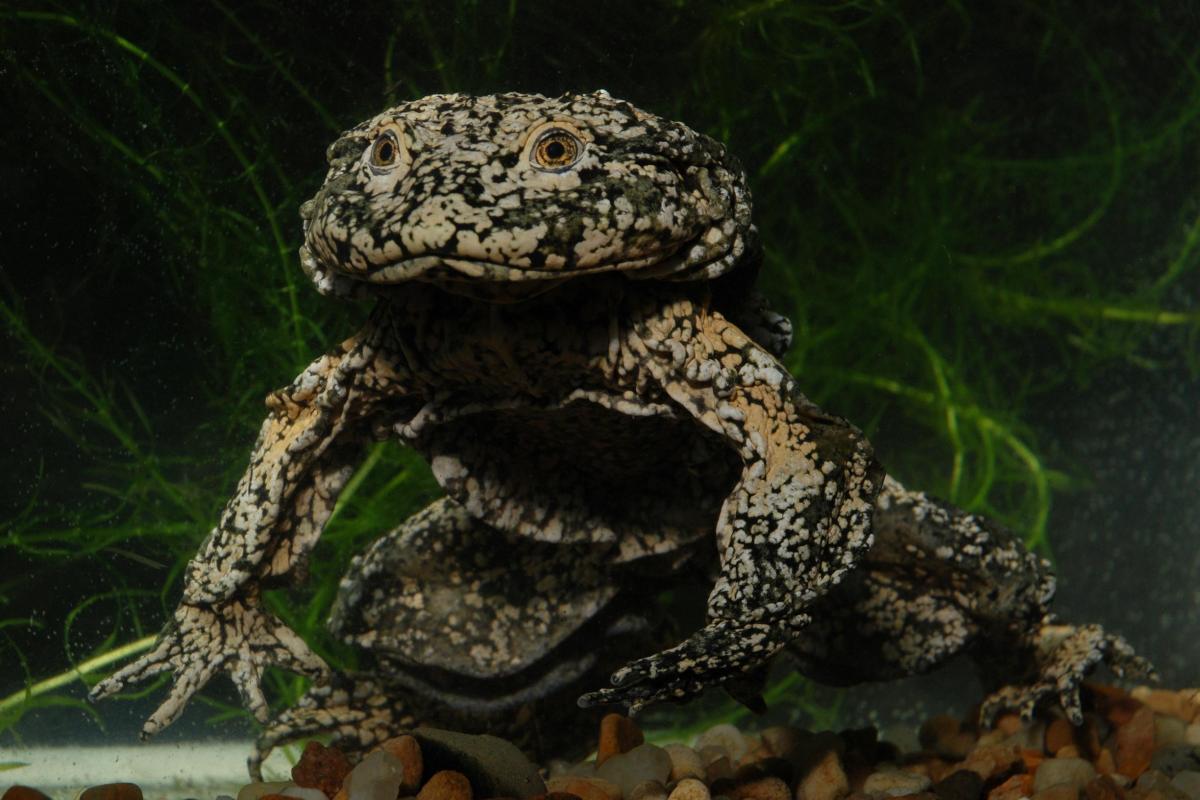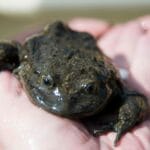A Frog Like No Other
High in the Andes Mountains, nestled between Peru and Bolivia, lies Lake Titicaca, the world’s highest navigable lake. This extraordinary lake is home to an equally extraordinary creature: the Lake Titicaca frog, affectionately known as the “scrotum frog” due to its unique, wrinkled skin. This fascinating amphibian, far from your typical green, hopping frog, is large, wrinkly, and spends most of its time underwater.
The Lake Titicaca frog has developed remarkable adaptations to survive in the lake’s challenging environment. The lake’s high altitude means thinner air, resulting in lower oxygen levels. To thrive in this oxygen-scarce environment, the frog’s skin has evolved to become loose and baggy, increasing its surface area and allowing it to absorb more oxygen directly from the water. This remarkable adaptation has often been compared to having a built-in scuba tank!
Facing an Uncertain Future
Sadly, this incredible species is facing a serious threat to its survival. Pollution from various sources, including agriculture, mining, and human waste, is contaminating the lake, making it increasingly difficult for the frogs to thrive. Additionally, the introduction of non-native fish species has created competition for resources and, in some cases, even predation on young frogs. Illegal capture for the pet trade further compounds these threats, pushing the Lake Titicaca frog towards an uncertain future.
Hope on the Horizon
Fortunately, hope remains for the Lake Titicaca frog. Scientists and conservationists are diligently working to protect this unique species. Efforts are underway to create safe havens, protecting breeding grounds and offering respite from the threats present in the lake. Collaboration with local communities is also crucial, aiming to reduce pollution and promote sustainable practices that benefit both the frogs and the people who share their environment.
A Window into Adaptation and Ecosystem Health
The Lake Titicaca frog is more than just a fascinating creature; it’s a valuable subject of scientific study. Some experts believe that by unraveling the secrets behind the frog’s remarkable adaptations to an extreme environment, we might glean insights into how other species adapt to similar challenges. Additionally, the frog’s role in the local ecosystem is crucial. Understanding the delicate balance of this ecosystem and the frog’s place within it can inform broader conservation efforts for similar species worldwide.
The story of the Lake Titicaca frog highlights the interconnectedness of our world. Protecting this unique species goes beyond saving a single frog; it’s about preserving biodiversity, ensuring ecosystem health, and acknowledging the intricate web of life on our planet.
Just How Big Are These Giant Frogs?
The Lake Titicaca frog is not your average pond dweller; these are giants among frogs! Officially known as Titicaca water frogs, they can grow to be an impressive two feet long, rivaling the size of a dinner plate. This remarkable size earns them the title of the largest fully aquatic frog in the world.
Their impressive size is not merely a coincidence; it’s directly linked to their high-altitude home. The thin air and water at such elevations mean less available oxygen. Over time, these frogs have adapted. Their skin has become incredibly wrinkled, resembling a prune, and this is their secret to survival. Those wrinkles significantly increase their surface area, allowing them to absorb more oxygen directly from the water, effectively functioning as a natural scuba suit.
Their size and wrinkly skin are just the tip of the iceberg when it comes to their remarkable adaptations. These frogs play a vital role in Lake Titicaca’s ecosystem, acting as a natural balancing force. By feeding on algae, they help maintain the lake’s health. Furthermore, they serve as an essential food source for other animals, securing their place as a critical link in the food chain.
Unlocking the Secrets of the “Scrotum Frog”
The Titicaca frog, with its unusual, baggy skin, has earned itself the rather amusing nickname of the “scrotum frog.” While this nickname might elicit a chuckle, it stems from a remarkable adaptation.
Remember that Lake Titicaca sits high in the mountains where the air, and consequently the water, has less oxygen. This is where the Titicaca frog’s baggy skin comes into play. This loose skin increases its surface area, allowing it to absorb more oxygen directly from the water, essentially breathing through its skin.
This “scrotum frog” is a true homebody, spending its entire life underwater in Lake Titicaca. And these aren’t small frogs! They can grow up to 8 inches long, excluding their legs, securing their position as one of the largest entirely aquatic frogs on Earth. Their flat bodies and webbed feet make them perfectly adapted for a life in the water, turning them into expert swimmers.
Despite its comical nickname and unique appearance, the Titicaca frog is facing a challenging future. Pollution from mining and agriculture, habitat destruction, and the introduction of invasive species competing for resources have all contributed to their decline, leading to them being classified as endangered.
The good news is that their story is not over. People are actively working to protect these unusual creatures and their home. Ongoing conservation efforts focus on cleaning up the lake, preserving their habitat, and, hopefully, helping their population recover. Their story serves as a crucial reminder that even the smallest creatures, regardless of their unusual nicknames, play a vital role in maintaining the delicate balance of our world.
Unveiling the Truth About the Titicaca Frog
The Titicaca water frog, more affectionately known as the “scrotum frog” due to its excessively wrinkled skin, is critically endangered. This unique amphibian exists solely in the high-altitude Lake Titicaca basin, straddling the border of Peru and Bolivia.
This remarkable frog, entirely at home in the water, can reach up to 2 feet in length. It boasts several unique adaptations, most notably its baggy skin. This unusual feature increases surface area, allowing it to absorb oxygen in the thin, oxygen-poor waters of Lake Titicaca, located high in the Andes Mountains.
Once a common sight in the lake, Titicaca frog populations have drastically declined. Pollution, primarily from mining activities, along with habitat degradation and the introduction of invasive species, have all contributed to their plight, urging conservationists to act swiftly.
Despite being nominated for the less than flattering title of “ugliest animal,” the Titicaca frog plays a vital role in its ecosystem. It serves as a crucial indicator of water quality, its health reflecting the overall health of the lake. Moreover, it stands as a powerful symbol of the region’s rich biodiversity.
Key Points:
- Unique Species: The Lake Titicaca frog is found exclusively in Lake Titicaca, the world’s highest navigable lake.
- Remarkable Adaptations: Its loose, baggy skin allows for increased oxygen absorption, an essential adaptation to the lake’s low oxygen levels.
- Multiple Threats: The frog faces threats from pollution, invasive fish species, habitat destruction, and illegal capture for the pet trade.
- Conservation Efforts: Scientists and conservationists are working to protect the frog by establishing safe breeding havens, reducing pollution, and raising awareness.
- Scientific and Ecological Importance: The Lake Titicaca frog provides valuable insights into adaptation to extreme environments and plays a crucial role in maintaining its ecosystem’s health.
- Cultural Significance: The frog holds cultural importance for indigenous communities living around Lake Titicaca.
- Conservation is Key: Protecting this unique species is crucial for preserving biodiversity, ecosystem health, and the intricate web of life on Earth.
People’s Statement:
- “[The Titicaca water frog is] one of the most important and emblematic species of the Lake Titicaca ecosystem. On one hand, it has deep cultural roots, and on the other, it has ecological importance within the lake system because it contributes to the persistence of ecological processes.” (Source: Re:wild)
- Unveiling Bernhard Caesar Einstein’s Scientific Achievements: A Legacy in Engineering - July 15, 2025
- Uncover who is Jerry McSorley: CEO, Family Man, Business Success Story - July 15, 2025
- Discover Bernhard Caesar Einstein’s Scientific Contributions: Unveiling a Legacy Beyond Einstein - July 15, 2025
















1 thought on “The Fight for Survival: Protecting the Lake Titicaca Frog from Extinction”
Comments are closed.